mixotrophics
5K posts
Don't wanna be here? Send us removal request.
Text

The Militant Methods of the N.W.S.P.U. *(National Womens' Social and Political Union, a militant wing of the British suffragettes)
(Being the verbatim Report of a Speech by Christabel Pankhurst, at the St. James's Hall, on October 15th, 1908)
Ladies and Gentlemen,
We have been working for the vote for forty years, but I do not think we shall have to wait very much longer. It is true that the Liberal Government is bitterly hostile to the reform that we are fighting for. The members of the present Government do not want to give votes to women. But man proposes and woman disposes ; and whether they like it or not, when the womanhood of the nation demands political enfranchisement, the Government has to give in. I say the present Government is hostile to Woman Suffrage. Probably some of you will retort—those of you who are not politically experienced will retort—that we have friends in the Cabinet. What about Mr. Lloyd George, what about Mr. Sydney Buxton, and certain other Cabinet Ministers who tell us that they believe that women ought to have the vote? Well, we say that anybody with the smallest knowledge of constitutional matters will be well aware that membership of a Government which as a whole denies votes to women is quite incompatible with friendship to our cause. No man who believes in Woman Suffrage can possibly remain a member of the present Government. His membership of this Government means that he is hostile to our claim.
0 notes
Text
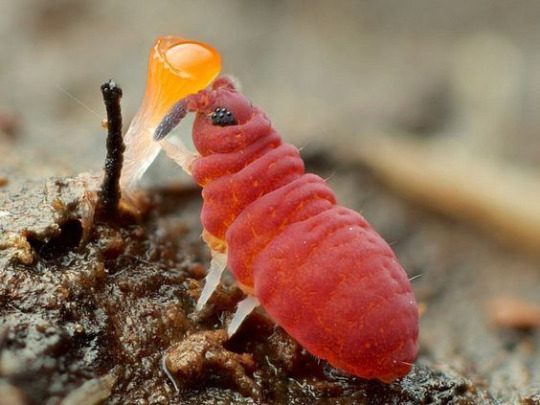
springtail eating a slime mold
by Andy Murray
11K notes
·
View notes
Text
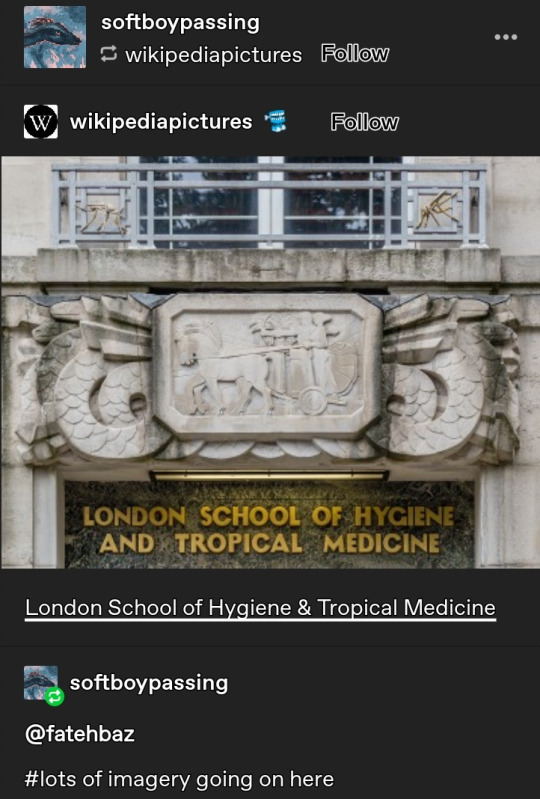
"defending civilization against bugs"
lol the mosquito sculpture

see Pratik Chakrabarti's Medicine and Empire: 1600-1960 (2013) and Bacteriology in British India: Laboratory Medicine and the Tropics (2012)
---
Sir Ronald Ross had just returned from an expedition to Sierra Leone. The British doctor had been leading efforts to tackle the malaria that so often killed English colonists in the country, and in December 1899 he gave a lecture to the Liverpool Chamber of Commerce [...]. [H]e argued that "in the coming century, the success of imperialism will depend largely upon success with the microscope."
Text by: Rohan Deb Roy. "Decolonise science - time to end another imperial era." The Conversation. 5 April 2018.
---
---
---
[A]s [...] Diane Nelson explains: The creation of transportation infrastructure such as canals and railroads, the deployment of armies, and the clearing of ground to plant tropical products all had to confront [...] microbial resistance. The French, British, and US raced to find a cure for malaria [...]. One French colonial official complained in 1908: “fever and dysentery are the ‘generals’ that defend hot countries against our incursions and prevent us from replacing the aborigines that we have to make use of.” [...] [T]ropical medicine was assigned the role of a “counterinsurgent field.” [...] [T]he discovery of mosquitoes as malaria and yellow fever carriers reawakened long-cherished plans such as the construction of the Panama Canal (1904-1914) [...]. In 1916, the director of the US Bureau of Entomology and longtime general secretary of the American Association for the Advancement of Science rejoiced at this success as “an object lesson for the sanitarians of the world” - it demonstrated “that it is possible for the white race to live healthfully in the tropics.” [...] The [...] measures to combat dangerous diseases always had the collateral benefit of social pacification. In 1918, [G.V.], president of the Rockefeller Foundation, candidly declared: “For purposes of placating primitive and suspicious peoples, medicine has some decided advantages over machine guns." The construction of the Panama Canal [...] advanced the military expansion of the United States in the Caribbean. The US occupation of the Canal Zone had already brought racist Jim Crow laws [to Panama] [...]. Besides the [...] expansion of vice squads and prophylaxis stations, during the night women were picked up all over the city [by US authorities] and forcibly tested for [...] diseases [...] [and] they were detained in something between a prison and hospital for up to six months [...] [as] women in Panama were becoming objects of surveillance [...].
Text by: Fahim Amir. "Cloudy Swords." e-flux Journal Issue #115. February 2021.
---
---
---
Richard P. Strong [had been] recently appointed director of Harvard’s new Department of Tropical Medicine [...]. In 1914 [the same year of the Panama Canal's completion], just one year after the creation of Harvard’s Department of Tropical Medicine, Strong took on an additional assignment that cemented the ties between his department and American business interests abroad. As newly appointed director of the Laboratories of the Hospitals and of Research Work of United Fruit Company, he set sail in July 1914 to United Fruit plantations in Cuba, Guatemala, Honduras, Costa Rica, and Panama. […] As a shareholder in two British rubber plantations, [...] Strong approached Harvey Firestone, chief executive of the tire and rubber-processing conglomerate that bore his name, in December 1925 with a proposal [...]. Firestone had negotiated tentative agreements in 1925 with the Liberian government for [...] a 99-year concession to optionally lease up to a million acres of Liberian land for rubber plantations. [...]
[I]nfluenced by the recommendations and financial backing of Harvard alumni such as Philippine governor Gen. William Cameron Forbes [the Philippines were under US military occupation] and patrons such as Edward Atkins, who were making their wealth in the banana and sugarcane industries, Harvard hired Strong, then head of the Philippine Bureau of Science’s Biological Laboratory [where he fatally infected unknowing test subject prisoners with bubonic plague], and personal physician to Forbes, to establish the second Department of Tropical Medicine in the United States [...]. Strong and Forbes both left Manila [Philippines] for Boston in 1913. [...] Forbes [US military governor of occupied Philippines] became an overseer to Harvard University and a director of United Fruit Company, the agricultural products marketing conglomerate best known for its extensive holdings of banana plantations throughout Central America. […] In 1912 United Fruit controlled over 300,000 acres of land in the tropics [...] and a ready supply of [...] samples taken from the company’s hospitals and surrounding plantations, Strong boasted that no “tropical school of medicine in the world … had such an asset. [...] It is something of a victory [...]. We could not for a million dollars procure such advantages.” Over the next two decades, he established a research funding model reliant on the medical and biological services the Harvard department could provide US-based multinational firms in enhancing their overseas production and trade in coffee, bananas, rubber, oil, and other tropical commodities [...] as they transformed landscapes across the globe.
Text by: Gregg Mitman. "Forgotten Paths of Empire: Ecology, Disease, and Commerce in the Making of Liberia's Plantation Economy." Environmental History, Volume 22, Number 1. January 2017. [Text within brackets added by me for clarity and context.]
---
---
---
[On] February 20, 1915, [...] [t]o signal the opening of the Panama-Pacific International Exposition (PPIE), [...] [t]he fair did not officially commence [...] until President Wilson [...] pressed a golden key linked to an aerial tower [...] whose radio waves sparked the top of the Tower of Jewels, tripped a galvanometer, [...] swinging open the doors of the Palace of Machinery, where a massive diesel engine started to rotate. [...] [W]ith lavish festivities [...] nineteen million people has passed through the PPIE's turnstiles. [...] As one of the many promotional pamphlets declared, "California marks the limit of the geographical progress of civilization. For unnumbered centuries the course of empire has been steadily to the west." [...] One subject that received an enormous amount of time and space was [...] the areas of race betterment and tropical medicine. Indeed, the fair's official poster, the "Thirteenth Labor of Hercules," [the construction of the Panama Canal] symbolized the intertwined significance of these two concerns [...]. [I]n the 1910s public health and eugenics crusaders alike moved with little or no friction between [...] [calls] for classification of human intelligence, for immigration restriction, for the promotion of the sterilization and segregation of the "unfit," [...]. It was during this [...] moment, [...] that California's burgeoning eugenicist movement coalesced [...]. At meetings convened during the PPIE, a heterogenous group of sanitary experts, [...] medical superintendents, psychologists, [...] and anthropologists established a social network that would influence eugenics on the national level in the years to come. [...]
In his address titled "The Physician as Pioneer," the president-elect of the American Academy of Medicine, Dr. Woods Hutchinson, credited the colonization of the Mississippi Valley to the discovery of quinine [...] and then told his audience that for progress to proceed apace in the current "age of the insect," the stringent sanitary regime imposed and perfected by Gorgas in the Canal Zone was the sine qua non. [...]
Blue also took part in the conference of the American Society for Tropical Medicine, which Gorgas had cofounded five years after the annexation of Cuba, Puerto Rico, and the Philippines. Invoking the narrative of medico-military conquest [...], [t]he scientific skill of the United States was also touted at the Pan-American Medical Congress, where its president, Dr. Charles L. Reed, delivered a lengthy address praising the hemispheric security ensured by the 1823 Monroe Doctrine and "the combined genius of American medical scientists [...]" in quelling tropical diseases, above all yellow fever, in the Canal Zone. [...] [A]s Reed's lecture ultimately disclosed, his understanding of Pan-American medical progress was based [...] on the enlightened effects of "Aryan blood" in American lands. [...] [T]he week after the PPIE ended, Pierce was ordered to Laredo, Texas, to investigate several incidents of typhus fever on the border [...]. Pierce was instrumental in fusing tropical medicine and race betterment [...] guided by more than a decade of experience in [...] sanitation in Panama [...]. [I]n August 1915, Stanford's chancellor, David Starr Jordan [...] and Pierce were the guests of honor at a luncheon hosted by the Race Betterment Foundation. [...] [At the PPIE] [t]he Race Betterment booth [...] exhibit [...] won a bronze medal for "illustrating evidences and causes of race degeneration and methods and agencies of race betterment," [and] made eugenics a daily feature of the PPIE. [...] [T]he American Genetics Association's Eugenics Section convened [...] [and] talks were delivered on the intersection of eugenics and sociology, [...] the need for broadened sterilization laws, and the medical inspection of immigrants [...]. Moreover, the PPIE fostered the cross-fertilization of tropical medicine and race betterment at a critical moment of transition in modern medicine in American society.
Text by: Alexandra Minna Stern. Eugenic Nation: Faults and Frontiers of Better Breeding in Modern America. Second Edition. 2016.
325 notes
·
View notes
Photo
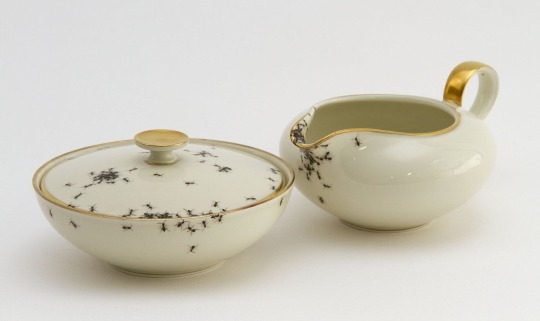



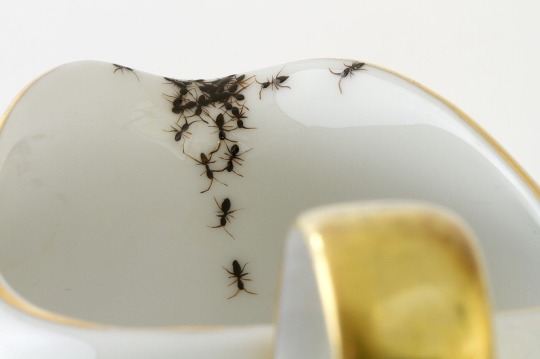
Vintage Porcelain Covered With Hand-Painted Ants by La Philie
165K notes
·
View notes
Note
May I have a happy one?-
Of Course!
Callosamia angulifera
Common Name: Tuliptree Silkmoth Caterpillar
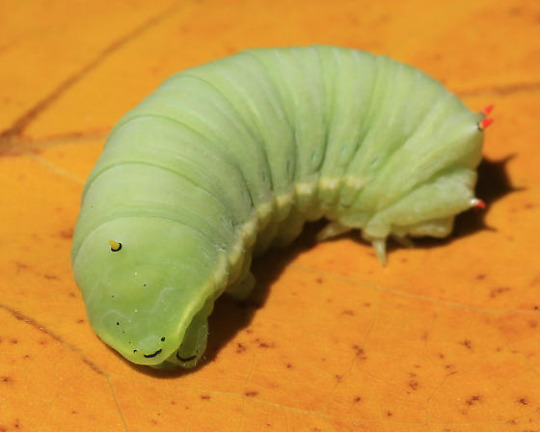
They have a little smiley face on the back of them!
32 notes
·
View notes
Text
went to a meeting with other conservation/restoration workers of various stripes and beforehand we went on a walk. many of course were entomologists, botanists, etc...
like half of us at any given time were crawling around on all fours in the dirt. artistic rendition below

3 notes
·
View notes
Text

went to the dentist today, they told me im gonna die in 3 hours
22K notes
·
View notes
Text
[E]very [interspecies] meeting in fact reminds us that the being we meet is and always shall be strange to us […]. When beings meet there is a distance between, such that in encountering the slug we also encounter something beyond the slug – a multitude of life we cannot sense. [...] So despite shared histories and the close proximity in which slugs and [humans] live, the slug retains a certain darkness as a creature apart; something is held in reserve […]. And so fleeting awareness of the irretrievability of the lives of others intensifies poignancy, such that despite a gulf separating the [human] from other creatures, some connection, however fleeting, is made to something – however strange. Refusing to dismiss the everyday and the banal is an ethical response. […] Slugs are there: sliming, chomping, and oozing around quietly and that should be enough to give them consideration.
[Text by: Franklin Ginn. “Sticky lives: Slugs, detachment and more-than-human ethics in the garden.” Transactions of the Institute of British Geographers, Volume 39, Issue 4. 2013. Bold emphasis added by me.]
---
So, can an insect speak? And if yes, do we understand it? Wittgenstein maintained that ‘if a lion could speak we would not understand him’, by which he implied that we do not share the ‘form of lion-life’ that would make lion language fully transparent to us […]. A similar insight was [...] expressed by [...] [a twentieth-century] honeybee researcher [...]: Beyond the appreciable facts of their life we know but little of the bees. And the closer our acquaintance becomes, the nearer is our ignorance brought to us of the depths of their real existence. But such ignorance is better than the other kind, which is unconscious and satisfied.
[Text by: Eileen Crist. “Can an Insect Speak?: The Case of the Honeybee Dance Language.” Social Studies of Science, Volume 34, Issue 1. 2004. Bold emphasis added.]
---
Animal studies scholarship tends to emphasize animal-human relations, encounters, and similarities. […] Jellyfish and other gelatinous creatures [...], however, float at the far reaches of our ability to construct sturdy interspecies connections [...]. Uexkull’s theory […] insists upon multiple worlds […], a capacious admission that a multitude of other creatures dwell as part of worlds that humans cannot readily or completely access or grasp. Three-quarters of a century later Terry Tempest Williams wonders what it would be like to be a jellyfish. […] [She] writes: “Perhaps this is what moves me most about jellies – their sensory intelligence […] the great hunger that is sent outward through the feathery reach of their tentacles. Imagine the information sought and returned.”
[Text by: Stacy Alaimo. “Jellyfish Science, Jellyfish Aesthetics: Posthuman Reconfigurations of the Sensible”. In: Thinking with Water. 2013. Bold emphasis added.]
---
Although we cannot ‘speak’ with nonhumans in any straightforward way, what we can and more importantly do do is become articulate with them in various ways. [...] If there is a way out of this historical impasse [alienation, climate crisis, global ecological degradation], [for some] it is not to be found in attributing some of ‘our’ qualities to ‘them’. It “would not be a matter of ‘giving speech back’ to animals […]. Perhaps the task is not to seek to compare the dance language of bees […] with human language, the ‘intelligence’ […] of Monarch butterflies with human intelligence, […] but rather (or at least in addition) to find a way of thinking about these ‘remarkable things’ that grants them positive ontological difference in their own right. […] [It] is concerned with what is always a multitude of others rather than a singular other […]; and it is radically nonanthropocentric […].
[Text by: Nick Bingham. “Bees, Butterflies, and Bacteria: Biotechnology and the Politics of Nonhuman Friendship.” Environment and Planning A: Economy and Space, Volume 38, Issue 3. 2006. Bold emphasis added.]
---
Starfish may seem to be still, but longer attention [...] shows them [slowly] moving, changing. [...] Then there are beings [like some insects] that experience hundreds, thousands of generations within a human lifetime. For such beings, the memories, learnings and modes of passing on experience are, it almost goes without saying (yet it must be said as it is so often not), radically different from any human’s in terms of the ways they experience change. The immensity of the alterity is, literally, incomprehensible to humans. We can't know what these beings know. But we can be aware that they have knowledges and experiences beyond us. [...] [W]e should know they live and experience and think beyond us. We should seek respect and be aware of how our lives are entangled […]. It is not abstract, or empty.
[Text by: Bawaka Country et al. “Gathering of the Clouds: Attending to Indigenous understandings of time and climate through songspirals.” Geoforum Volume 108. January 2020. Bold emphasis added.]
718 notes
·
View notes
Text

dune cricket comm!! what a neat little freak, with those feet
551 notes
·
View notes
Text


This small, pale egg sac is a distinctive sign of Agroeca brunnea, a rather discreet ground-living spider from the family Liocranidae.
The species is widely distributed across Europe and can be found in a variety of habitats—both moist and dry—including forests, wetlands, and meadows. Adults are most commonly seen from May to July, hunting at ground level among leaf litter and low vegetation. Though the spider itself is rarely noticed, its uniquely shaped egg sac—often suspended just above the ground or tucked beneath leaves—is easier to spot and serves as a tell-tale sign of its presence.
In several European languages, the spider has earned poetic names inspired by the shape of its egg sac: in German, Feenlämpchenspinne ("fairy-lamp spider"); in Dutch, lantaarnspin ("lantern spider"); and in Swedish, skogslyktspindel, or "forest lantern spider". Though it lacks an established English name, “fairy-lamp spider” has been suggested—and it certainly fits.
Jätteberget nature reserve in Närke, Sweden May 25, 2025).
225 notes
·
View notes
Text

This image was captured last weekend at Malin Head, County Donegal, during Storm Éowyn.
Pic. Michael Mc Daid S Photography
5K notes
·
View notes
Text


I was planning to do more for my main's refs but never got around to finishing all of the sketches. Might as well post them up. Repping the freak Sylvari 😔
614 notes
·
View notes
Text

The Mouth of Mordremoth
This Elder Dragon from GUILD WARS 2 still intrigues me to this day. The fact that it used to be corporeal, before 'growing into' the Heart of Maguuma itself, present within the vines and only physically manifest as the Mouth, makes me wonder what it really used to look like before all that.
Art Prints | RedBubble Shop
1K notes
·
View notes












